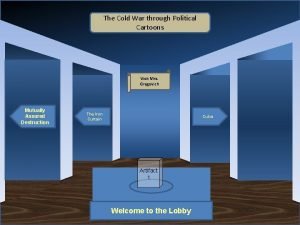Lets get Physical Physical as in Science Have












- Slides: 12

Let’s get Physical, Physical – as in Science! Have you ever played twenty questions?

A little Science Humor What does this have to do with Physical properties? • Two fish swim by a fisherman’s baited hook. One fish says t the other, “You know, I never could figure out why those worms always go swimming with lead weights tied around their necks. ” • The other fish replies, “Yeah, they must be pretty dense. ”

Physical Properties • One that can be observed or measured without changing the matter’s identity. • Examples include magnetism, the conducting of electricity, strength, flexibility, color, odor, mass, volume, etc.

More Physical Properties • Thermal Conductivity – the rate at which a substance transfers heat • State – the physical form a substance is in • Solubility – the ability of a substance to dissolve in another substance • Ductility – the ability of a metal to be pulled in a wire • Malleability – the ability of a substance to be rolled or pounded into thin sheets

Question Time • 1. A property that be observed or measured without changing the substance is a a. chemical property b. magnetic property c. physical property • 2. The ability of an object to be rolled into sheets is a. ductility b. malleability c. solubility d. state • 3. The ability of a substance to dissolve in a liquid is a. malleability b. ductility c. solubility d. thermal conductivity • 4. The ability of a substance to be drawn into a wire is a. ductility b. malleability c. solubility d. state • 5. The rate at which a substance transfers heat is a. state b. solubility c. thermal conductivity d. malleability • 6. The physical form that matter is in is a. state b. thermal conductivity c. malleability d. solubility

How do we Identify Matter? • We use physical properties every day to do it. • Are your socks clean? Do they smell? • Does your shirt match your pants? • Does your science book fit into your backpack? • How does a Vending Machine work?

Density • The amount of matter in a give amount of space or volume • Different liquids can form separate layers if they are of a different density. • What would you rather carry around – a kg of feathers or a kg of lead? • Knowing the volume that these objects take up might help you decide

It’s time to play “Will it Sink or Will it Float? ” • Let’s try to predict whether these items will sink or float? Are we as good as David Letterman? • An egg, an orange, a can of pop, a ½ pint of milk, a can of diet pop • What else would you like to try?

Using Density to Identify Substances • To find density – you take mass divided by volume • Some substances are easy are identify by density • Water has a density of 1 g/ml • Lead is 11. 35 g/ml while mercury is 13. 55 g/ml • What is the density of an object whose mass is 25 kg and has a volume of 10 ml? • 2. 5 g/ml • What is the mass of a 15 ml sample of mercury? • D x V = M (203 grams)

Does a Physical change create a new substance? Physical changes affect one or more of the physical properties of a substance. Examples include Freezing water to make ice cubes; sugar dissolving in water, melting butter, molding a lump of clay Physical changes do not change the identity of the matter involved.

Question Time • 1. Density is a. mass x volume b. mass – volume c. mass divided by volume d. mass + volume • 2. T or F – Physical changes create new substances.

Summary of Physical Properties • Physical properties of matter can be observed without changing the identity of the matter. • Examples of physical properties include conductivity, solubility, malleability, ductility, density, state, etc. • Density is the amount of matter in a given space. • Scientists like to use density because it is always the same at a given temperature and pressure • Substances undergoing physical changes are still the same substance. • Examples of physical changes are freezing, bending, melting, dissolving, and cutting.
 Get on get in get off
Get on get in get off Alliteration in one direction songs
Alliteration in one direction songs Lets get a lock for this thing cartoon
Lets get a lock for this thing cartoon Lets get to know each other
Lets get to know each other Lets get started images
Lets get started images Reported speech lets
Reported speech lets Let's have a review
Let's have a review Lets recap
Lets recap Favourite subject science
Favourite subject science Get up get moving quiz
Get up get moving quiz Get up get moving quiz
Get up get moving quiz Get up get moving quiz
Get up get moving quiz Pseudocode sequence
Pseudocode sequence





















